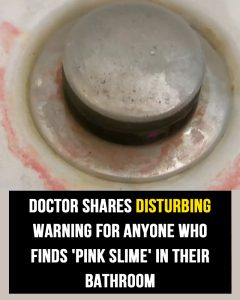In many households across America, you might notice a pinkish film forming in bathrooms, especially around drains, shower curtains, and the grout between tiles. At first glance, it’s easy to mistake this discoloration for mold, but the real culprit is something else entirely. This pink residue is actually caused by a type of bacteria known as Serratia marcescens. This microorganism thrives in moist environments and feeds off the fatty substances left behind by soap, shampoo, and other personal care products.

Dr. Karan Raj, a surgeon affiliated with the National Health Service (NHS), shed light on this often misunderstood bathroom invader. “If you’ve spotted this pink slime lurking in your bathroom, it’s not mold—it’s bacteria,” Dr. Raj explained. He went on to clarify that Serratia marcescens “loves damp, moist places and enjoys munching on fatty deposits like those found in soaps and shampoos; hence why it likes to hang out in your bathroom.” It turns out, your typical shower environment is like an all-you-can-eat buffet for this resilient little bacterium.
While Serratia marcescens is usually harmless to healthy individuals, it’s not entirely innocent. According to Infectious Disease Advisor, this bacterium is widespread in nature, existing in soil, water, plants, and even animals. In the home, it tends to settle in wet, unventilated areas like shower corners and wash basins, where it becomes visible due to the red-colored pigment called prodigiosin that it produces. That pinkish hue you see isn’t just unpleasant to look at—it’s a sign that bacteria are setting up shop.
For people with compromised immune systems, including hospitalized patients, elderly individuals, and those dealing with chronic illnesses, Serratia marcescens can be much more than just an unsightly nuisance. Exposure to the bacteria can lead to serious infections, particularly in the urinary tract, respiratory system, or open wounds. Treating these infections can be quite challenging because Serratia marcescens tends to be resistant to a wide range of antibiotics, making prompt and effective medical attention critical when infections arise.
@dr.karanr Pink slime club @Anna ♬ original sound – Dr Karan Rajan
Dr. Raj emphasized the need for vigilance, especially when it comes to contact with the eyes or any open wounds. “You still want to avoid getting it in your eyes or open wounds,” he cautioned. Moreover, he pointed out that the persistent dampness found in many bathrooms doesn’t just invite Serratia marcescens—it can also create a breeding ground for other dangerous organisms, such as black mold. Black mold is far more hazardous, especially because it can lead to serious respiratory problems if inhaled over time. The stakes for maintaining a clean and dry bathroom are higher than you might have thought.
Fortunately, there are practical steps you can take to keep your bathroom from becoming a haven for bacteria and mold. First, proper ventilation is key. Make sure your bathroom is well-ventilated by running exhaust fans during and after showers or opening windows to help reduce humidity levels. This simple step goes a long way toward disrupting the moist environment that bacteria and mold love.
Second, regular cleaning is essential. Frequently clean your bathroom surfaces with disinfectants that contain bleach or hydrogen peroxide. Pay special attention to areas that tend to stay damp, such as shower curtains, tile grout, and around sinks. Regular cleaning doesn’t just remove bacteria—it also helps prevent new colonies from taking hold.
Third, stay on top of plumbing issues. Any leaks should be addressed immediately, no matter how minor they may seem. Even a small drip can create a consistently wet area, offering the perfect spot for bacteria and mold to flourish. Proactive maintenance helps cut off these threats before they can become bigger problems.
Finally, decluttering your shower space can make a difference. Try to limit the number of bottles, razors, and other products you store in the shower area. Every surface offers another spot for moisture and bacteria to gather, so keeping things minimal helps reduce the potential for bacterial growth. Less clutter not only makes cleaning easier but also enhances the overall hygiene of your bathroom.
By adopting these preventative measures, you can significantly minimize the risk of Serratia marcescens taking over your bathroom. Even more importantly, you’ll create a healthier living environment for yourself and your family. A few simple habits—ventilating properly, cleaning regularly, fixing leaks promptly, and reducing clutter—can have a profound impact on keeping your home safe from harmful microorganisms.
The bottom line? The pink residue you often find in bathrooms isn’t mold—it’s Serratia marcescens bacteria. While it may not pose a serious threat to people in good health, it can become a significant health hazard for those whose immune systems are compromised. Infections from this bacteria can be stubborn and difficult to treat, thanks to its natural resistance to many antibiotics. Recognizing its presence early and taking action can help you avoid unnecessary health complications.
Maintaining a clean and dry bathroom isn’t just about appearances—it’s about protecting your health and the health of those you love. Serratia marcescens might be a tough organism, but with consistent attention and good cleaning habits, it doesn’t stand a chance against an informed and proactive homeowner. Did you know about the hidden risks lurking behind that harmless-looking pink slime? Now that you do, it’s time to stay one step ahead and keep your bathroom safe and sparkling.





